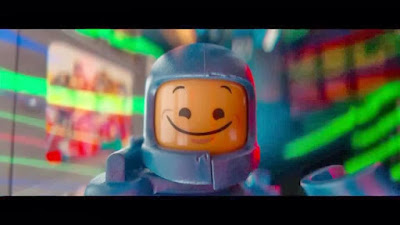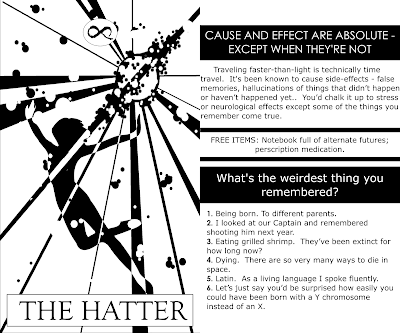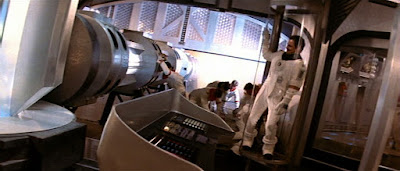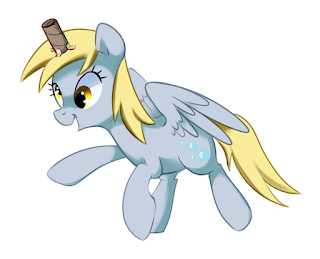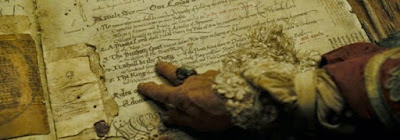 |
Improving page layout was a low bar.
|
So in mid-1999 my friends and I were talking about making a TTPRG of our own. I don't know how common that was back then; I knew exactly two people with internet at the time and had never heard of PDFs. This was to be a printed book and sold in brick and mortar stores.
I don't know if any of us thought it would actually happen. But it was fun to imagine.
The book was going to be beauty, too. Not a mere hardback tome with glossy pages and color art; this was going to be a book that was actually useful. Heavy-gauge spiral bound so the pages lay flat. Hard plastic covers with the game's name embossed. Chapter tabs built in. A comprehensive index. A pocket in the front for commonly used tables and one in the back for a dozen blank character sheets.
We were sweet summer children. Compared to the play-focused designs of today, our book was hopelessly outclassed.
That said, we were trying to get away from a trend that was already in full swing in the late nineties and would continue for the next fifteen years. Game books and Adventures weren't made to actually be used in those days - they were made to be read. And they were oftentimes a great read.
READABILITY VS PLAYABILITY
The original post for last week's blog had an entire paragraph on the splat books from the D&D 3.x years. I still have mine. Heck, I still read them - they are great inspiration for the imagination. The Stronghold Builder's Guidebook, the Races books - the DMG II has a section on life in a medieval setting that I practically memorized.
But.
These books weren't inspiring me to, ya know, game.
If I ever get around to writing fantasy stories, you can bet the D&D 3.x books will be used as reference. But I didn't buy them because I wanted to write. And they didn't inspire my games very much either.
Even if they did inspire me to game, most of the books were hard to use at the table. They required shuffling between stacks of hardbacks, endless page flipping, and even with a DM screen it was hard to get a decent play flow going because magic.
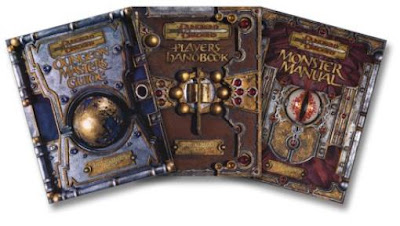 |
Okay, so the spell casters are in the front of the middle book, the spells are in the back of the middle book, the magic items are in the book on the left, the monsters that cast spells are in the book on the right...
|
4th Edition, for all of it's faults, was much easier to use at the table. But I hadn't seen anything in terms of table utility until I started looking and Indie RPGs. Mothership. Into the Odd. Maze Rats.
THE CONTROL PANEL LAYOUT AND BEYOND
The Control Panel layout was a revelation.
In retrospect, it's such a simple idea: Every double-page spread is devoted to a single subject, and everything about that subject is on the double-page spread. No flipping to another section, no checking for material in another book.
Brilliant.
But Ben from Questing Beast made rather fanciful speculation on his blog about layouts that I cannot get out of my head:
"It got me wondering whether you could make an entire RPG in the form of cardstock handouts, somewhere between A4 and A5 sized."
Could that work?
Turns out the answer is yes. Yes it can.
Not only can that work, cardstock handouts have advantages other formats lack:
- You don't have to share a book. Heck, there's no book to share! Information that an individual player needs for their character is available in a single-page format that can used while other players have access to the rest of the cards.
- Handouts are a solved problem: Adventure maps, as just one example, are no longer bound in the same book that the adventure's less player-facing assets are. A map can simply be removed from the card stack and placed on the table. Or an NPC portrait. There's already an entire game with card-based assets available that has rave reviews.
- All assets are modular. References or tables from multiple books become multiple cards - much easier to handle. The caption from the image above wouldn't exist with cards. Like Ben said, "Player wants to play a wizard? Hand him the card with the magic rules and the card with the spell list."
These are just a few examples.
I wondered why there weren't more games using this format until I started to try it out. Having every rule, map, item and table on individual cards sounds good in theory, but how do you organize everything? Color codes? Pages of Collectible Card sheets in a ring binder, like Pokemon or Magic Cards? Utility can exist only if Accessibility is preserved. As annoying as the tables of contents or indices for some RPGs can be, at least the pages didn't change order.
Fortunately, there is a rather, pardon the pun, old-school technique we can look into.
INDEX CARDS AND ANALOG DATABASES
As I've mentioned once or twice, I'm kinda old. Not old enough to have used punched-card computers, but I was in collage before card catalogs were phased out. In high school, when I had to write a term paper, I wasn't forbidden to use Wikipedia as a citation, but I was required to collect and document x number of works cited on 3x5 index cards. I mention this because back when people used index cards all the time they still needed a way to organize and search the data thereon.
Enter the Edge-Notch Card Index.
I don't recall these from my youth Back In The Day but various systems were still in use in the 1980s and are probably used privately if not commercially today.
The principle is fairly simple: By punching holes in the edge of the cards, you can pick them all up on a rod or wire. If you notch some of those holes on specific cards, then a rod or wire inserted in a stack of cards will not pick the notched cards up. They will fall out. You can double-punch the cards or devise codes for organizing the cards to enable searching by multiple terms or searching more terms than holes or any number of possible variations including using more than one rod in combination with the above methods.
Here's a video found on Hackaday that demonstrates the system's utility.
The advantages for organizing a completely card-based TTRPG are many. Just think of possibilities:
- The cards are just as searchable out-of-order. As long as they're all right-side up and facing the same way (a problem solved by beveling one corner) the cards are searchable no matter where they are in the stack. This means that no matter how much you use, reuse or pass the cards around during play, you can just put them all back in the box at the end of the evening and they will be as easy to search and access next time you use them.
- You can have as many copies of a specific card as you want/need: I'm sure everyone that's played a game has at least once wished you had another copy of the chargen rules. Or the weapons table, or the range chart, et cetera ad nauseum. Now you can, without buying a whole other book. And you can put the copies in the main stack, anywhere you want, and they'll still be as searchable and accessible as the original.
- You can add new information and errata without sacrificing accessibility: This alone is worth the cost of admission. With the exception of GURPS No TTRPG I've played included an index in every book or supplement. Edge Notched cards not only eliminate the separate index, they eliminate the need for a separate index. You can make a new adventure, a new rule set, additional classes, equipment - what ever you want, and as long as you add the right combination of holes and notches, you can stack them all together in one box. Errata does not require page references and quotations. Just issue a new card and it can go in the stack to replace the old.
- The stacks are fractal. As long as you have a stack with more than one card, you can search that stack using the the system of organization you selected. You can take a huge stack, split it into multiple packets and search those separately.
Or you can combine stacks or shuffle stacks or anything - that's the genius of the edge-notched cards. As long as you line up the beveled corners, the cards cannot be randomized. You will always be able to find the card you're looking for.
There's so much potential In these. A double layer of holes could allow for storing completely different games in the same stack. If A5 doesn't provide enough space for what you need on a card, you could mirror the bevels, holes and notches top-and-bottom and fold the card in half to make it fit in a stack. You could make multiple games or multiple categories of cards by varying the size of the cards - instead of DMG, PH and MM, you could have 5x8, 3x5 and 2.5x3.5.
Or anything.
I'd like to extend a special thank you to Mr. Winchell D. Chung Jr., aka Nyrath the Nearly-Wise. I first discovered Edge Notched cards on his website Atomic Rockets, along with Nomograms and other goodies. As I've said before, This website and the Blue Max Studios back catalog would not exist without Mr. Chung and Atomic Rockets.
